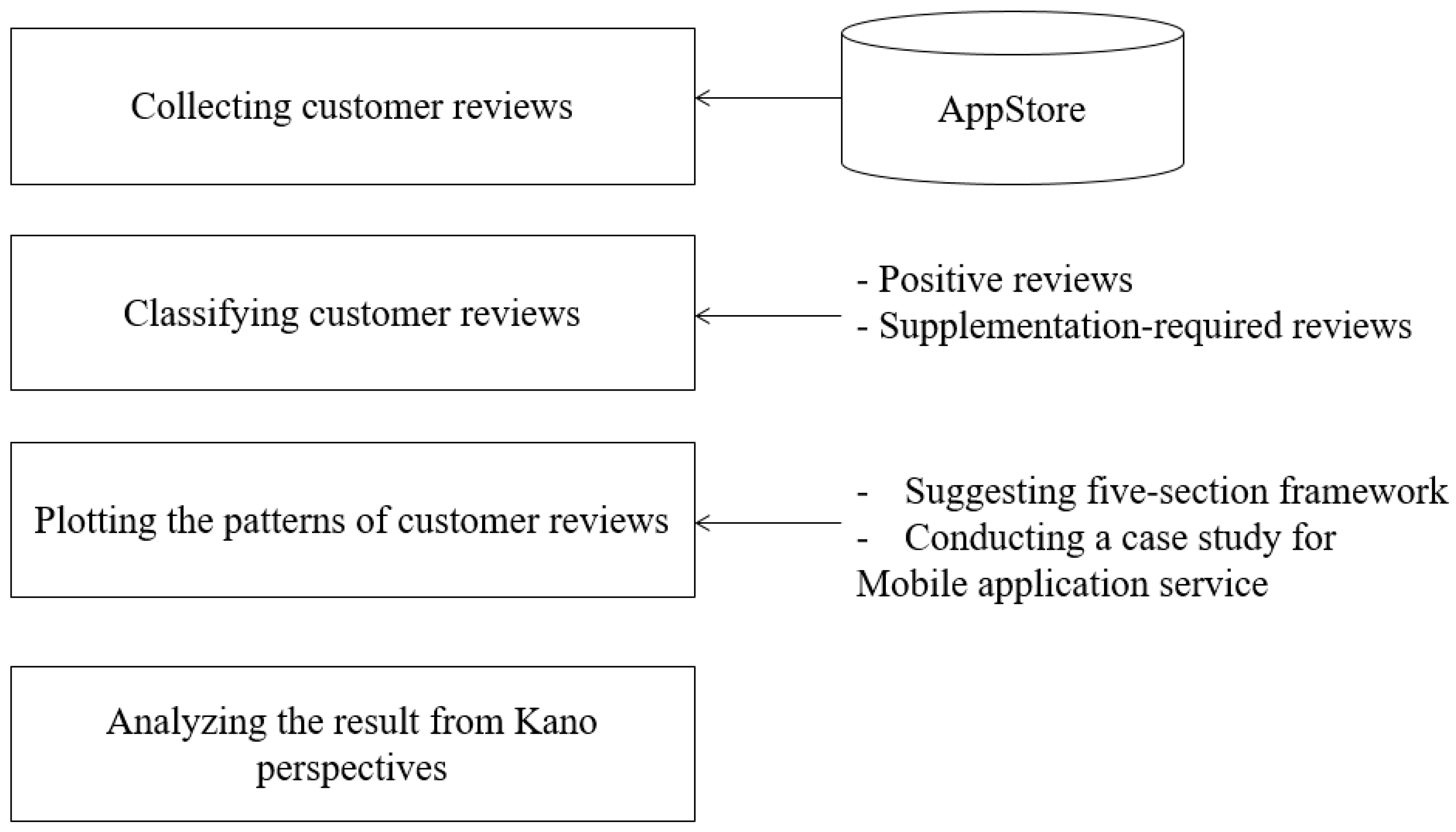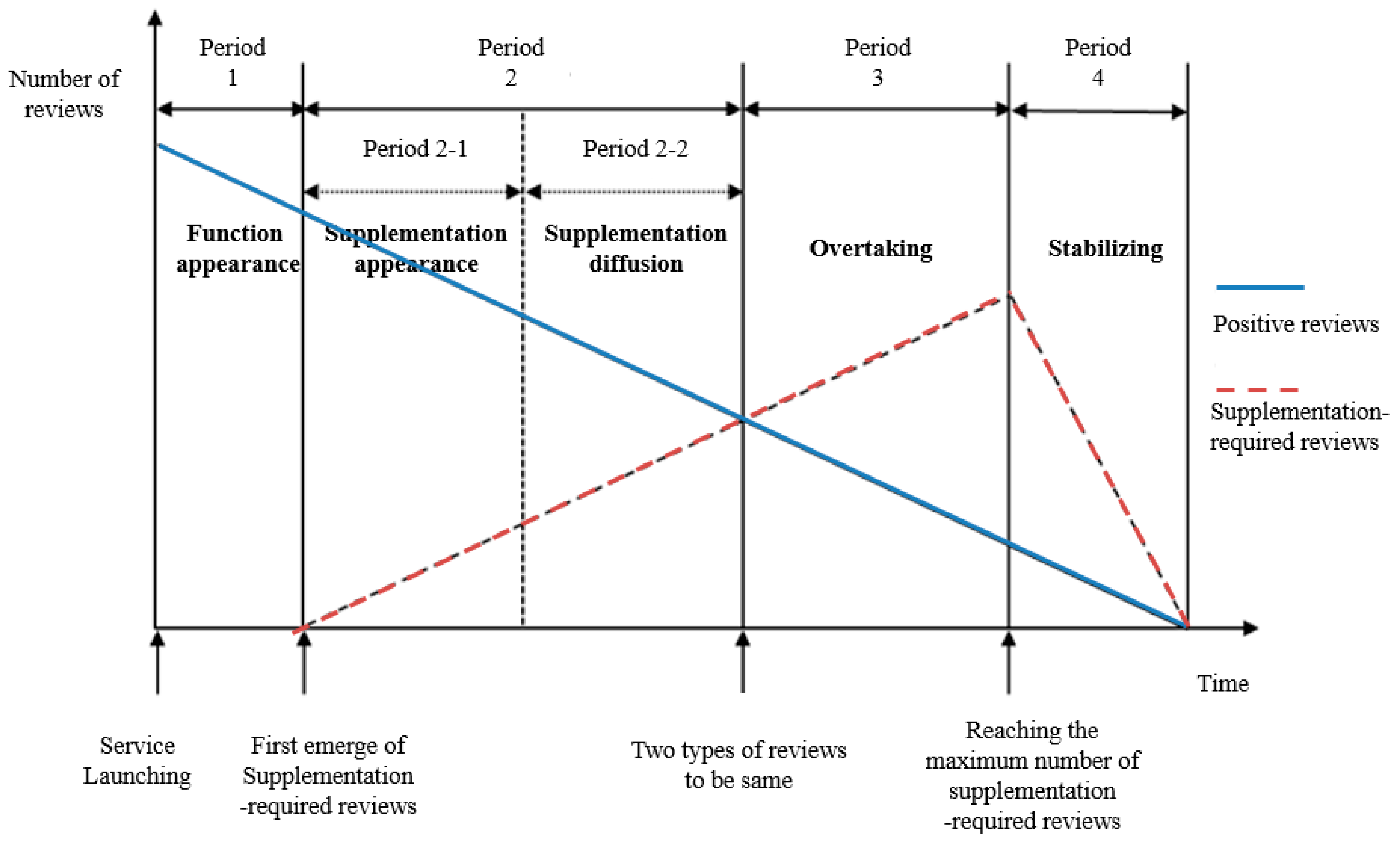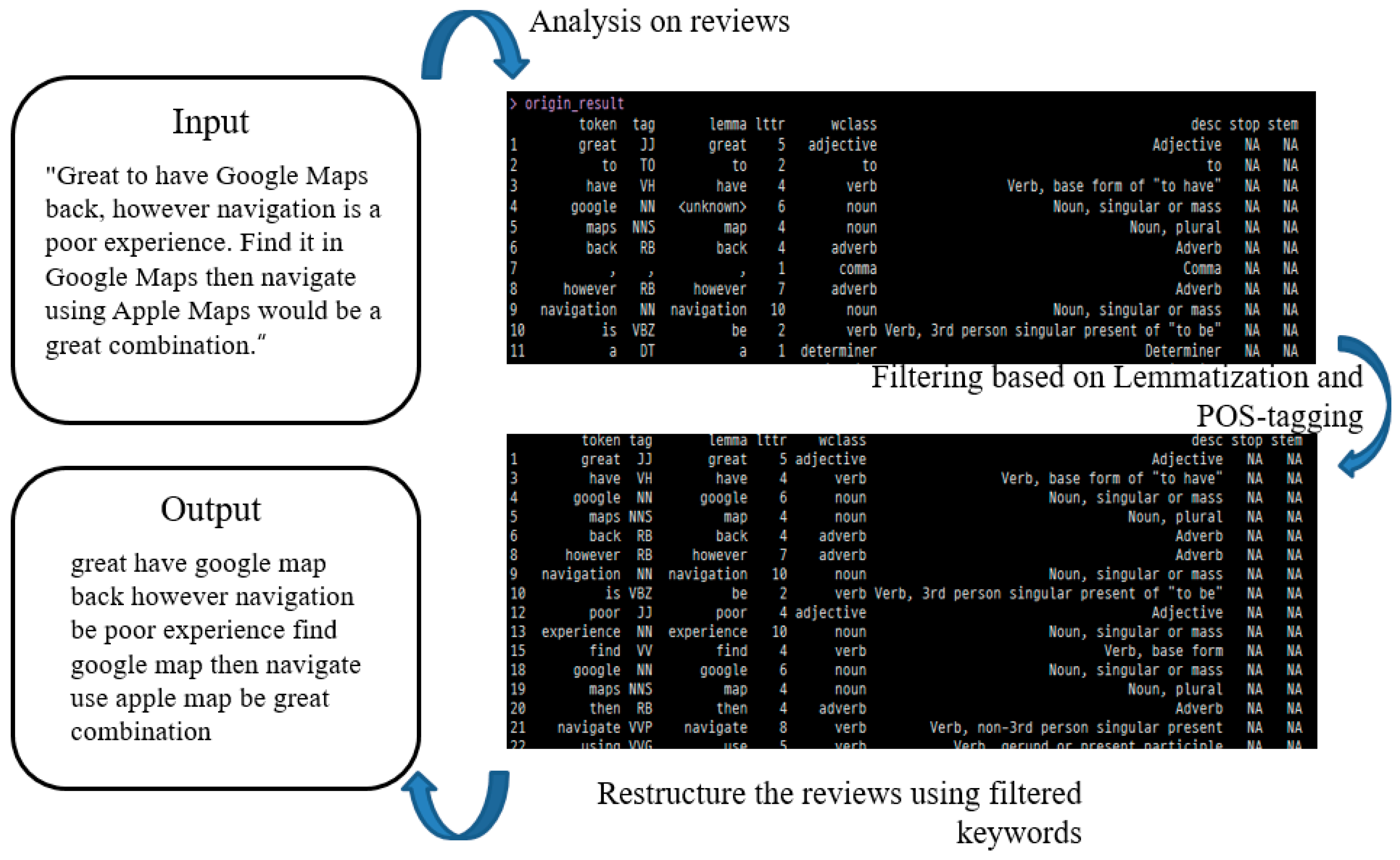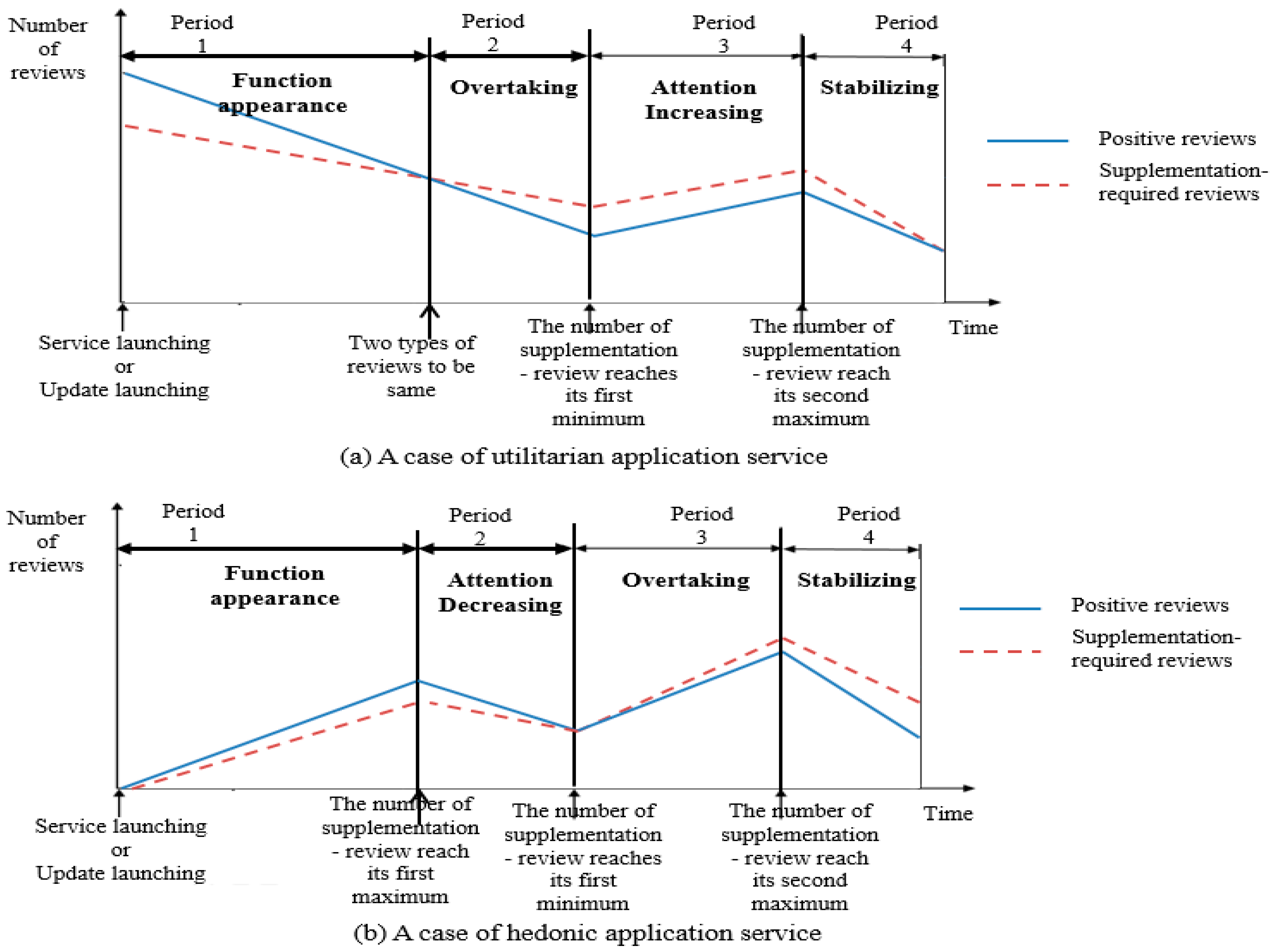Analyzing Dynamic Change in Customer Requirements: An Approach Using Review-Based Kano Analysis
Abstract
1. Introduction
2. Literature Review
2.1. Customers in Service Innovation
2.2. Kano Model and Its Dynamic Characteristics
2.3. Customer Review as an Excellent Source in Internet Commerce
2.4. Sentiment Analysis for Analyzing Customer Reviews
3. Proposed Approach
3.1. Research Framework
3.2. Assumption
3.3. Collecting Customer Reviews
3.4. Classifying Customer Reviews
3.5. Plotting the Dynamic Pattern of Customer Reviews
3.6. Analyzing the Result from Kano Perspectives
4. Illustrative Examples
4.1. Case Overview
- When at least one supplementation-required word occurs in the customer review, this review is classified as a supplementation-required customer review.
- When positive words occur without any supplementation-required words, this review is classified as a positive customer review.
- When only one supplementation-required words occurs and the number of positive words >5 supplementation-required words, this review is classified as a positive customer review even if supplementation-required words occur. The rule is used because there are many cases that customers feel really happy for the service, but may suggest a minor update. Therefore, when the number of positive words is more than five words (which mean that customers are really satisfied) and only one supplementation-required word occurs (which means customers’ suggestion might be minor compared to their satisfaction), this review is classified as a positive customer review even if supplementation-required words occur.
4.2. Result
4.3. Discussion
4.3.1. Function vs. Service
4.3.2. Emergence Time of Supplementation Required Review
4.3.3. Unbalanced Dictionary
4.4. Managerial Implication
5. Conclusions
Acknowledgments
Author Contributions
Conflicts of Interest
Appendix A
| Positive words | Opinion lexicon from https://www.cs.uic.edu/~liub/FBS/sentiment-analysis.html#lexicon (This is a list of English positive and negative opinion words, and we extract only positive words [44]) |
| Supplementation-required words | cannot?, not possible, impossible, want, please, pls, plz, need, would be better, d be better, would be great, would like to, d like to, have to, hope, wish, must, try, if i can, let’s make, can you make, can u make, if there, if only there, if you could, should be able to, fix, revise, adjust, modify, convert, renovate, gripe, rather than, change, error, mistake, wrong, inaccurate, rubbish, dangerous, disappoint, not work, poor, lost, delete, bug, fix, incorrect, frustrate, useless, drawback, unnecessary, delete, sluggish, different, inability, out of date, stupid, ignore, unlike, shock, slow, buffer, terrible, fuss, confuse, danger, not easy, not work, skip, ugly, hard, issue, misplace, awful, rubbish, fault, not clear, try again, crash, old, cancel, loose, lost, flaw, not find, frustrate, fail, worst, horrible, accident, unable, refuse, annoy, unintelligible, lack, wait, go back, problem, disappoint, lag, miss, problem, improve, improving, develop, complain, solve, put, addition, add more, few, make it, create, unusable, put it back, useful, improve |
References
- Brombacher, A.C.; Sander, P.C.; Sonnemans, P.J.; Rouvroye, J.L. Managing product reliability in business processes ‘under pressure’. Reliab. Eng. Syst. Saf. 2005, 88, 137–146. [Google Scholar] [CrossRef]
- Vargo, S.L.; Lusch, R.F. Evolving to a new dominant logic for marketing. J. Mark. 2004, 68, 1–17. [Google Scholar] [CrossRef]
- Lusch, R.F.; Vargo, S.L.; O’Brien, M. Competing through service: Insights from service-dominant logic. J. Retail. 2007, 83, 5–18. [Google Scholar] [CrossRef]
- Grönroos, C. Value co-creation in service logic: A critical analysis. Mark. Theory 2011, 11, 279–301. [Google Scholar] [CrossRef]
- Goldenberg, J.; Libai, B.; Muller, E. Talk of the network: A complex systems look at the underlying process of word-of-mouth. Mark. Lett. 2001, 12, 211–223. [Google Scholar] [CrossRef]
- Joo, Y.H.; Kim, Y.; Yang, S.J. Valuing customers for social network services. J. Bus. Res. 2011, 64, 1239–1244. [Google Scholar] [CrossRef]
- Ordenes, F.V.; Theodoulidis, B.; Burton, J.; Gruber, T.; Zaki, M. Analyzing customer experience feedback using text mining: A linguistics-based approach. J. Serv. Res. 2014, 17, 278–295. [Google Scholar] [CrossRef]
- Kano, N. Life cycle and creation of attractive quality. In Proceedings of the 4th Quality Management and Organizational Development (QMOD) Conference, Linkping, Sweden, 12–14 September 2001; pp. 18–36. [Google Scholar]
- Kano, N.; Seraku, N.; Takahashi, F.; Tsuji, S. Attractive quality and must-be quality. J. Jpn. Soc. Qual. Control 1984, 14, 147–156. [Google Scholar]
- Nilsson-Witell, L.; Fundin, A. Dynamics of service attributes: A test of Kano’s theory of attractive quality. Int. J. Serv. Ind. Manag. 2005, 16, 152–168. [Google Scholar] [CrossRef]
- Bickart, B.; Schindler, R.M. Internet forums as influential sources of consumer information. J. Interact. Mark. 2001, 15, 31–40. [Google Scholar] [CrossRef]
- Chou, S.Y.; Picazo-Vela, S.; Pearson, J.M. The effect of online review configurations, prices, and personality on online purchase decisions: A study of online review profiles on ebay. J. Internet Commer. 2013, 12, 131–153. [Google Scholar] [CrossRef]
- Chen, Y.; Xie, J. Online consumer review: Word-of-mouth as a new element of marketing communication mix. Manag. Sci. 2008, 54, 477–491. [Google Scholar] [CrossRef]
- Verhoef, P.C.; Reinartz, W.J.; Krafft, M. Customer engagement as a new perspective in customer management. J. Serv. Res. 2010, 13, 247–252. [Google Scholar] [CrossRef]
- Witell, L.; Kristensson, P.; Gustafsson, A.; Löfgren, M. Idea generation: Customer co-creation versus traditional market research techniques. J. Serv. Manag. 2011, 22, 140–159. [Google Scholar] [CrossRef]
- Zeithaml, V.A.; Parasuraman, A.; Berry, L.L. Problems and strategies in services marketing. J. Mark. 1985, 49, 33–46. [Google Scholar] [CrossRef]
- Fließ, S.; Kleinaltenkamp, M. Blueprinting the service company: Managing service processes efficiently. J. Bus. Res. 2004, 57, 392–404. [Google Scholar] [CrossRef]
- Zhao, M.; Roy Dholakia, R. A multi-attribute model of web site interactivity and customer satisfaction: An application of the Kano model. Manag. Serv. Qual. Int. J. 2009, 19, 286–307. [Google Scholar] [CrossRef]
- Herzberg, F.; Mausner, B.; Snyderman, B. The Motivation to Work; Wiley: New York, NY, USA, 1959. [Google Scholar]
- Witell, L.; Löfgren, M.; Dahlgaard, J.J. Theory of attractive quality and the Kano methodology–the past, the present, and the future. Total Qual. Manag. Bus. Excell. 2013, 24, 1241–1252. [Google Scholar] [CrossRef]
- Tontini, G. Integrating the Kano model and QFD for designing new products. Total Qual. Manag. 2007, 18, 599–612. [Google Scholar] [CrossRef]
- Shahin, A.; Zairi, M. Kano model: A dynamic approach for classifying and prioritising requirements of airline travellers with three case studies on international airlines. Total Qual. Manag. 2009, 20, 1003–1028. [Google Scholar] [CrossRef]
- Llinares, C.; Page, A.F. Kano’s model in Kansei Engineering to evaluate subjective real estate consumer preferences. Int. J. Ind. Ergon. 2011, 41, 233–246. [Google Scholar] [CrossRef]
- Lin, S.; Niu, D. Empirical study on electric power customer satisfaction based on Kano model. In Proceedings of the IITA International Conference 2009 SSME’09 Services Science, Management and Engineering, Zhangjiajie, China, 11–12 July 2009. [Google Scholar]
- Huiskonen, J.; Pirttilä, T. Sharpening logistics customer service strategy planning by applying Kano’s quality element classification. Int. J. Prod. Econ. 1998, 56, 253–260. [Google Scholar] [CrossRef]
- Matzler, K.; Fuchs, M.; Schubert, A. Employee satisfaction: Does Kano’s model apply? Total Qual. Manag. Bus. Excell. 2004, 15, 1179–1198. [Google Scholar] [CrossRef]
- Kim, J.; Geum, Y.; Park, Y. Integrating customers’ disparate technology readiness into technological requirement analysis: An extended Kano approach. Total Qual. Manag. Bus. Excell. 2017, 28, 678–694. [Google Scholar] [CrossRef]
- Randall Brandt, D. How service marketers can identify value-enhancing service elements. J. Serv. Mark. 1988, 2, 35–41. [Google Scholar] [CrossRef]
- Belkahla, W.; Triki, A. Customer knowledge enabled innovation capability: Proposing a measurement scale. J. Knowl. Manag. 2011, 15, 648–674. [Google Scholar] [CrossRef]
- Qi, J.; Zhang, Z.; Jeon, S.; Zhou, Y. Mining customer requirements from online reviews: A product improvement perspective. Inf. Manag. 2016, 53, 951–963. [Google Scholar] [CrossRef]
- Sun, S.; Luo, C.; Chen, J. A review of natural language processing techniques for opinion mining systems. Inf. Fusion 2017, 36, 10–25. [Google Scholar] [CrossRef]
- Xu, X.; Li, Y. The antecedents of customer satisfaction and dissatisfaction toward various types of hotels: A text mining approach. Int. J. Hosp. Manag. 2016, 55, 57–69. [Google Scholar] [CrossRef]
- Nasukawa, T.; Yi, J. Sentiment analysis: Capturing favorability using natural language processing. In Proceedings of the 2nd International Conference on Knowledge Capture, Sanibel Island, FL, USA, 23–25 October 2003; pp. 70–77. [Google Scholar]
- Kang, D.; Park, Y. Review-based measurement of customer satisfaction in mobile service: Sentiment analysis and VIKOR approach. Expert Syst. Appl. 2014, 41, 1041–1050. [Google Scholar] [CrossRef]
- Taboada, M.; Brooke, J.; Tofiloski, M.; Voll, K.; Stede, M. Lexicon-based methods for sentiment analysis. Comput. Linguist. 2011, 37, 267–307. [Google Scholar] [CrossRef]
- Ur-Rahman, N.; Harding, J.A. Textual data mining for industrial knowledge management and text classification: A business oriented approach. Expert Syst. Appl. 2012, 39, 4729–4739. [Google Scholar] [CrossRef]
- Zhong, N.; Li, Y.; Wu, S.T. Effective pattern discovery for text mining. IEEE Trans. Knowl. Data Eng. 2012, 24, 30–44. [Google Scholar] [CrossRef]
- Song, B.; Lee, C.; Yoon, B.; Park, Y. Diagnosing service quality using customer reviews: An index approach based on sentiment and gap analyses. Serv. Bus. 2016, 10, 775–798. [Google Scholar] [CrossRef]
- Salehan, M.; Kim, D.J. Predicting the performance of online consumer reviews: A sentiment mining approach to big data analytics. Decis. Support Syst. 2016, 81, 30–40. [Google Scholar] [CrossRef]
- Heinonen, K.; Pura, M. Classifying mobile services. In Proceedings of the Helsinki Mobility Roundtable, Helsinki, Finland, 1–2 June 2006; Volume 6. Sprouts: Working Papers on Information Systems. [Google Scholar]
- Okazaki, S. New perspectives on m-commerce research. J. Electron. Commer. Res. 2005, 6, 160–164. [Google Scholar]
- Kim, J.; Park, Y.; Kim, C.; Lee, H. Mobile application service networks: Apple’s App Store. Serv. Bus. 2014, 8, 1–27. [Google Scholar] [CrossRef]
- Schmid, H. Improvements in part-of-speech tagging with an application to German. In Proceedings of the ACL Sigdat-Workshop, Dublin, Ireland, 12–16 August 1995. [Google Scholar]
- Hu, M.; Liu, B. Mining and summarizing customer reviews. In Proceedings of the Tenth ACM SIGKDD International Conference on Knowledge Discovery and Data Mining, Seattle, WA, USA, 22–25 August 2004; pp. 168–177. [Google Scholar]





| Types of Reviews | Examples | |
|---|---|---|
| Positive reviews | I love this service! This is very convenient. | |
| Supplementation-required reviews | Update-required reviews | This service is too old-fashioned. Please update this. |
| Modification-required reviews | Ctrl-V is not working. Please amend it. | |
| Addition-required reviews | We need menus for clearing options. Please add these. | |
| Area | Area Name | Starting Point | Ending Point | Kano Feature |
|---|---|---|---|---|
| 1 | Function appearance area | Service first launched | Supplementation-review first emerges | Attractive |
| 2-1 | Supplementation appearance area | Supplementation-review first emerges | Supplementation-required reviews reach their predefined ratio | |
| 2-2 | Supplementation diffusion area | Supplementation-required reviews reach their predefined ratio | The number of positive and supplementation-required reviews are the same | |
| 3 | Overtaking area | The number of positive and supplementation-required reviews are the same | The number of supplementation-required reviews reach its maximum | |
| 4 | Stabilizing area | The number of supplementation-required reviews reach its maximum | The number of two types of reviews decreases | Must-be |
| Target | First Review in App Store | Characteristics | Number of Review |
|---|---|---|---|
| Aviary | 1 June 2012 | A photo-related application to use professionally designed filters, creative stickers and frames, and touch-up tools and to share photo in social network services (SNS) | 1112 |
| Camera360 | 22 June 2011 | A photo-editing application using hundreds of professional filters and fun stickers, providing active community with famous stars | 863 |
| Google Maps-navigation | 13 December 2012 | A navigation application to find the way to the desired places and get the information that users want. The real-time updates and traffic information is provided Transit information using bus, train, or ride-share is also provided. Live traffic, incidents, and road closures are also provided | 4286 |
| Google Maps-traffic | 1208 |
| Area | Area Name | Starting Point | Ending Point | Kano Feature |
|---|---|---|---|---|
| 1 | Function appearance area | Service first launched | The number of positive and supplementation-required reviews are the same | Attractive |
| 2 | Overtaking area | The number of positive and supplementation-required reviews are the same | The number of supplementation-required reviews reaches its first minimum | |
| 3 | Attention Increasing area | The number of supplementation-required reviews reaches its first minimum | The number of supplementation-required reviews reaches its second maximum | |
| 4 | Stabilizing area | The number of supplementation-required reviews reaches its second maximum | The number of two types of reviews decreases | Must-be |
| Area | Area Name | Starting Point | Ending Point | Kano Feature |
|---|---|---|---|---|
| 1 | Function appearance area | Service first launched | The number of supplementation- required reviews reaches its first maximum | Attractive |
| 2 | Attention decreasing area | The number of supplementation- required reviews reaches its first maximum | The number of supplementation- required reviews reaches its first minimum | |
| 3 | Overtaking area | The number of supplementation- required reviews reaches its first minimum | The number of supplementation- required reviews reaches its second maximum | |
| 4 | Stabilizing area | The number of supplementation- required reviews reaches its second maximum | The number of the two types of reviews decreases | Must-be |
© 2018 by the authors. Licensee MDPI, Basel, Switzerland. This article is an open access article distributed under the terms and conditions of the Creative Commons Attribution (CC BY) license (http://creativecommons.org/licenses/by/4.0/).
Share and Cite
Min, H.; Yun, J.; Geum, Y. Analyzing Dynamic Change in Customer Requirements: An Approach Using Review-Based Kano Analysis. Sustainability 2018, 10, 746. https://doi.org/10.3390/su10030746
Min H, Yun J, Geum Y. Analyzing Dynamic Change in Customer Requirements: An Approach Using Review-Based Kano Analysis. Sustainability. 2018; 10(3):746. https://doi.org/10.3390/su10030746
Chicago/Turabian StyleMin, Hyejong, Junghwan Yun, and Youngjung Geum. 2018. "Analyzing Dynamic Change in Customer Requirements: An Approach Using Review-Based Kano Analysis" Sustainability 10, no. 3: 746. https://doi.org/10.3390/su10030746
APA StyleMin, H., Yun, J., & Geum, Y. (2018). Analyzing Dynamic Change in Customer Requirements: An Approach Using Review-Based Kano Analysis. Sustainability, 10(3), 746. https://doi.org/10.3390/su10030746




